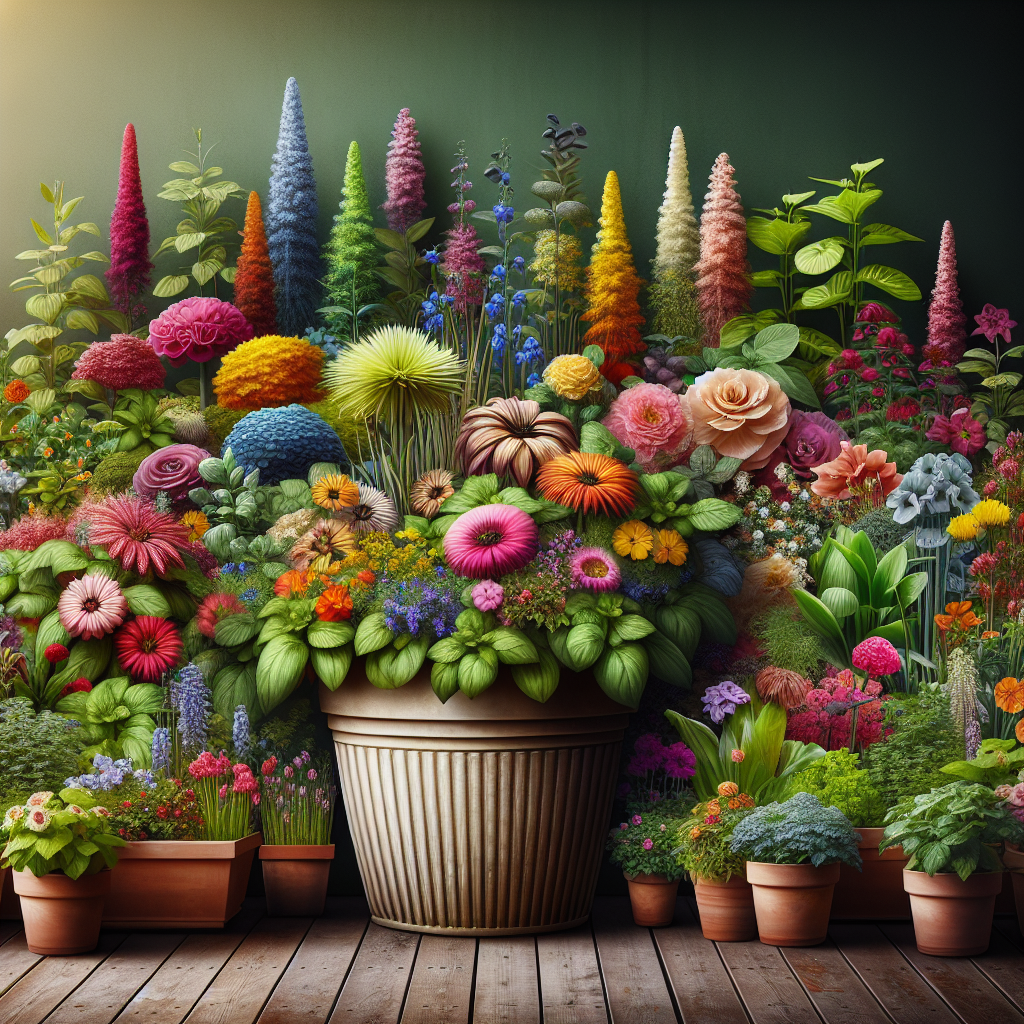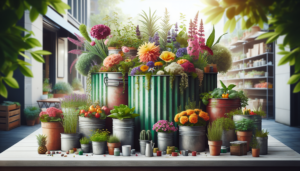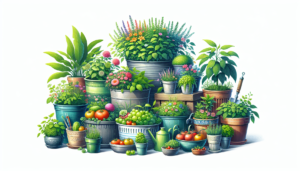
Imagine a flourishing garden right outside your window, filled with vibrant flowers, luscious vegetables, and aromatic herbs. With the right knowledge and techniques, creating this dream container garden is within your reach. In this article, we will guide you on how to craft a successful container garden using organic potting mix. Whether you’re a seasoned gardener or just starting your green journey, these tips and tricks will help you achieve a bountiful and eco-friendly oasis that will leave your neighbors envious. So grab your gardening gloves and get ready to transform your space into a vibrant haven of greenery and beauty.
Choosing the Right Container
When it comes to container gardening, choosing the right container is essential for the success of your plants. Here are a few factors to consider when selecting a container:
Consider the size
The size of the container is an important aspect to consider. The container must be large enough to accommodate the root system of your plant. If the container is too small, the roots may become cramped, leading to stunted growth. On the other hand, if the container is too large, it may retain too much water, drowning the plant. So, choose a container that suits the size of your plant.
Opt for drainage
Proper drainage is crucial for the health of your plants. Make sure your container has drainage holes at the bottom to allow excess water to escape and prevent waterlogging. Without proper drainage, the roots may become waterlogged, leading to root rot and other water-related issues.
Choose a material
Containers come in various materials such as clay, plastic, and wood. Each material has its pros and cons. Clay containers are porous and allow for air circulation, but they can dry out quickly. Plastic containers are lightweight and retain moisture well but may not be as aesthetically pleasing. Wood containers are more durable and provide good insulation, but they may require periodic treatment to prevent rot. Choose a material that suits your needs and the overall look you desire.
Ensure stability
Stability is another consideration when choosing a container. Ensure that your chosen container is stable and won’t topple over easily, especially during strong winds or when plants grow taller. If needed, place your container in a location where it can receive additional support, such as against a wall or secured to a railing.
Selecting the Right Organic Potting Mix
An organic potting mix is essential for the health and vitality of your container garden. It provides the necessary nutrients and structure for your plants to thrive. Here are a few things to consider when selecting an organic potting mix:
Understanding the importance of organic potting mix
Organic potting mix is made from natural and sustainable ingredients, free from synthetic chemicals and pesticides. It helps create a healthier environment for your plants and ensures that you are growing food and flowers free from harmful toxins.
Checking for quality
When selecting an organic potting mix, it is essential to check for quality. Look for a mix that is well-balanced and free from pests, diseases, and weeds. Read product labels and research different brands to ensure you are getting a high-quality mix.
Considering the needs of your plants
Different plants have different requirements. Some plants prefer well-draining soil, while others thrive in moisture-retaining soil. Consider the needs of your plants and choose a potting mix that caters to those requirements. For example, succulents and cacti prefer a mix with plenty of grit and sand, while leafy greens prefer a mix with good moisture retention.
Looking for specific ingredients
Certain ingredients, such as compost, aged manure, and coco coir, can enhance the quality of your potting mix. Look for mixes that contain these ingredients or consider adding them separately to improve the nutrition and water-holding capacity of your mix.
Preparing Your Container
Before planting your chosen plants, it is important to properly prepare your container. Follow these steps to ensure a healthy growing environment:
Clean and sanitize
Start by cleaning your container to remove any dirt, debris, or potential pests. Rinse the container with a mixture of water and mild detergent, then rinse thoroughly to remove any residue. Sanitize the container by soaking it in a solution of one part bleach to nine parts water for 10 minutes, then rinse thoroughly again.
Provide drainage holes
If your container does not already have drainage holes, carefully drill a few at the bottom. Ensure the holes are not too large or too close together to prevent soil from escaping while still allowing for adequate drainage.
Add a layer of gravel or broken pottery
To further improve drainage, add a layer of gravel or broken pottery pieces to the bottom of the container. This layer will prevent the drainage holes from getting clogged and ensure excess water can escape freely.
Create a saucer or tray
To catch any excess water that drains from the container, create a saucer or tray underneath. This will prevent water from pooling on your patio or indoor surface and help maintain a clean and tidy appearance.
Plant Selection
Choosing the right plants for your container garden is essential for a successful harvest. Consider the following factors when selecting plants:
Consider the space and sunlight
Assess the available space and the amount of sunlight your container will receive. Some plants require full sun, while others thrive in partial shade. Take note of any shade patterns caused by nearby structures or trees and select plants that will thrive in the available light conditions.
Choose varieties suitable for containers
Not all plants are suitable for container gardening. Look for varieties specifically bred or recommended for container growing. These plants are typically more compact and have stronger root systems that adapt well to the confines of a container. Herbs, cherry tomatoes, and many flower varieties are excellent choices for container gardening.
Consider companion planting
Companion planting involves growing different plants together that have beneficial relationships. Some plants repel pests, while others provide shade or suppress weeds. Research companion planting combinations and choose plants that can thrive in harmony together.
Account for growth and spacing
Consider the mature size of your chosen plants and allow enough space for their growth. Overcrowding can lead to competition for nutrients and decreased productivity. Follow spacing guidelines provided for each plant to ensure optimal growth and productivity.
Planting Techniques
Proper planting techniques are essential for the health and establishment of your plants. Follow these steps for successful planting:
Start with good root systems
When selecting plants, look for those with healthy root systems. Avoid purchasing plants with overcrowded or root-bound root systems, as they may struggle to establish themselves in the container. Look for plants with firm, white roots coming out of the bottom of the container.
Loosen the root ball
Gently loosen the roots of the plant before planting. This will encourage the roots to spread out and establish themselves more effectively in the new container. Gently massage the roots to separate them and remove any excess soil from the root ball.
Place the plant at the appropriate soil level
Plant your chosen plants at the appropriate soil level in the container. The soil level should match the level at which the plant was previously growing, with the crown of the plant (where the stems meet the roots) slightly above the soil line.
Backfill and firm the soil
Once the plant is in place, backfill the container with the organic potting mix, gently firming the soil around the roots. Ensure the soil is evenly distributed and that there are no air pockets. Leave a small gap between the soil surface and the top of the container to prevent water from overflowing when watering.
Watering and Fertilizing
Watering and fertilizing are crucial aspects of container gardening. Here are some guidelines to follow for proper care:
Watering frequency and amount
Container plants generally require more frequent watering compared to plants in the ground. Check the moisture level of the soil by gently sticking your finger about an inch into the soil. If it feels dry at that depth, it’s time to water. Be sure to water thoroughly, allowing water to reach all the way to the bottom of the container to encourage deep root growth.
Monitoring moisture levels
Do not let the soil completely dry out between waterings, as this can stress your plants. However, overwatering can lead to root rot and other water-related issues. Monitor the moisture levels of the soil regularly and adjust your watering schedule accordingly.
Using organic fertilizers
Organic fertilizers provide slow-release nutrients to your plants, promoting healthy growth. Use a balanced organic fertilizer specifically formulated for container plants. Follow the instructions on the fertilizer packaging for proper application rates and frequency.
Understanding the needs of different plants
Different plants have different nutrient requirements. Some plants, such as tomatoes and peppers, are heavy feeders and may require more frequent fertilization. Others, such as herbs and succulents, have lower nutrient needs. Research the specific nutrient requirements of your chosen plants to ensure they receive the proper care.
Pest and Disease Management
Preventing and managing pests and diseases is an essential part of maintaining a healthy container garden. Here are some tips to help you keep your plants pest and disease-free:
Promote plant health
Healthy plants are better equipped to resist pests and diseases. Provide optimal growing conditions with sufficient sunlight, proper watering, and a well-balanced organic potting mix. Regularly remove dead leaves and spent flowers to prevent the buildup of plant debris, which can attract pests and diseases.
Identify common pests and diseases
Learn to identify common pests and diseases that may affect your plants. Look out for signs such as holes in leaves, yellowing or wilting, sticky residue, or visible pests. Research specific pests and diseases that are prevalent in your region and learn effective organic management techniques.
Use organic pest control methods
Incorporate organic pest control methods to manage common garden pests. These can include hand-picking pests, using insecticidal soaps or natural predators, and employing organic pest repellents. Avoid using synthetic pesticides, as they can harm beneficial insects and disrupt the natural balance of your garden.
Practice preventive measures
Prevention is key when it comes to pest and disease management. Regularly inspect your plants for any signs of trouble and take action promptly. Implement practices like crop rotation, proper plant spacing, and regular deep watering to minimize the risk of pests and diseases.
Mulching and Weed Control
Mulching and controlling weeds are important tasks that help maintain the health and appearance of your container garden. Follow these steps for effective mulching and weed control:
Benefits of mulching
Mulching has numerous benefits for container plants. It helps conserve moisture in the soil, suppresses weed growth, moderates soil temperature, and improves overall soil health. Mulch also adds an aesthetic appeal to your container garden.
Choosing the right mulch
When selecting mulch, consider factors such as water retention, weed suppression, and visual appeal. Organic mulches like straw, shredded leaves, and wood chips are excellent choices for container gardening. Avoid using mulches that may contain weed seeds or pests.
Applying mulch properly
Apply a layer of mulch around your container plants, ensuring that the mulch does not touch the stems or foliage. This will help prevent rot and fungal diseases. Apply a layer about 2-3 inches deep to provide adequate coverage.
Preventing weed growth
Weed control is crucial in container gardening to avoid competition for nutrients and space. Regularly inspect your containers for weed growth and manually remove any weeds that appear. Applying mulch will also help suppress weed growth by blocking sunlight and preventing weed seeds from germinating.
Maintenance and Care
Regular maintenance and care are essential for the well-being of your container garden. Follow these guidelines to keep your plants thriving:
Regularly monitor and inspect your plants
Make it a habit to regularly inspect your plants for any signs of pests, diseases, or nutrient deficiencies. Check the moisture levels of the soil and adjust your watering schedule accordingly. Remove any dead or yellowing leaves to maintain the overall health and aesthetics of your container garden.
Pruning and deadheading
Prune your plants as needed to remove dead or damaged branches. Deadheading, or removing spent flowers, promotes continuous blooming and prevents seed development. Pruning and deadheading also improve airflow and reduce the risk of diseases.
Supporting tall plants
If you have tall or vining plants in your container garden, provide appropriate support to prevent them from toppling over. Use stakes, trellises, or cages to support the plants and ensure they grow upright. Regularly check and adjust the supports as the plants grow.
Protecting from extreme weather
Extreme weather conditions such as strong winds, frost, or intense heat can damage your container garden. Move your containers to a sheltered area or provide additional protection when severe weather is expected. Use frost blankets, shade cloth, or temporary structures to shield your plants from harsh conditions.
Harvesting and Enjoying the Fruits of Your Labor
The ultimate reward of container gardening is the joy of harvesting and enjoying the fruits (or flowers) of your labor. Here’s what you need to know:
Knowing when to harvest
Each plant has its specific harvesting time. Research the ideal harvesting time for your chosen plants and look for visual cues or physical indicators of ripeness. Depending on the plant, you may harvest fruits, vegetables, herbs, or cut flowers.
Proper harvesting techniques
Use clean, sharp tools to harvest your plants. Carefully cut or gently tug at mature fruits or vegetables to avoid damaging the plant. For herbs and cut flowers, harvest in the morning when the plants are at their peak freshness and remove just a small portion of the plant to allow for regrowth.
Preparing and enjoying the harvest
Once harvested, wash your produce thoroughly and prepare them according to your desired recipes. Savor the flavors and enjoy the pride of eating homegrown, organic produce. Share your bounty with friends and family to spread the joy of container gardening.
Saving seeds for future planting
If you have heirloom plants or favorite varieties, consider saving seeds for future planting. Allow the fruits or flowers to fully mature and dry, then collect the seeds and store them in a cool, dry place. Proper seed saving techniques will ensure a continuous supply of your favorite plants.
By following these comprehensive steps and guidelines, you can create a successful container garden using organic potting mix. Enjoy the process of nurturing your plants and delight in the beauty and productivity they bring into your life. Happy container gardening!







